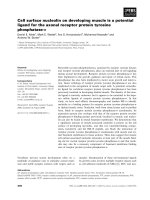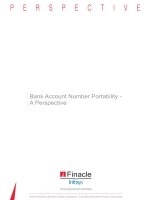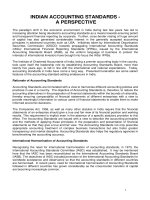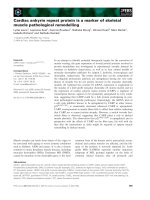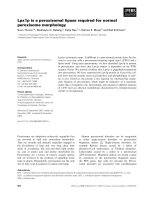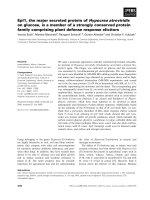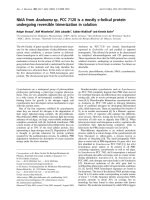Everyone is a customer pot
Bạn đang xem bản rút gọn của tài liệu. Xem và tải ngay bản đầy đủ của tài liệu tại đây (1.75 MB, 236 trang )
This publication is designed to provide accurate and authoritative information
in regard to the subject matter covered. It is sold with the understanding that
the publisher is not engaged in rendering legal, accounting, or other profes-
sional service. If legal advice or other expert assistance is required, the services
of a competent professional person should be sought.
Vice President and Publisher: Cynthia A. Zigmund
Editorial Director: Donald J. Hull
Senior Acquisitions Editor: Jean Iversen
Senior Managing Editor: Jack Kiburz
Interior Design: Lucy Jenkins
Cover Design: Jody Billert, Billert Communications
Typesetting: the dotted i
The Purposeful Collaboration Process is patent pending by The Rhythm of
Business, Inc. The Rhythm of Business is a registered trademark of The Rhythm
of Business, Inc.
© 2002 by The Rhythm of Business, Inc.
Published by Dearborn Trade Publishing, a Kaplan Professional Company
All rights reserved. The text of this publication, or any part thereof, may not
be reproduced in any manner whatsoever without written permission from
the publisher.
Printed in the United States of America
02 03 04 10987654321
Library of Congress Cataloging-in-Publication Data
Shuman, Jeffrey C., 1945–
Everyone is a customer : a proven method for measuring the value of
every relationship in the era of collaborative business / Jeffrey Shuman and
Janice Twombly, with David Rottenberg.
p. cm.
Includes bibliographical references and index.
ISBN 0-7931-5412-X
1. Customer relations. I. Twombly, Janice. II. Rottenberg, David,
1946– III. Title.
HF5414.5 S554 2002
658.8′12—dc21 2002002864
Dearborn Trade books are available at special quantity discounts to use for
sales promotions, employee premiums, or educational purposes. Please call
our Special Sales Department to order or for more information, at 800-621-9621,
ext. 4410, or e-mail Mindi Rowland at
iv Part One
❘
Part Title
OTHER BOOKS BY THE AUTHORS
Collaborative Communities: Partnering for Profit in the Networked
Economy, Dearborn Trade, 2001
The Rhythm of Business: The Key to Building and Running Success-
ful Companies, Butterworth-Heinemann, 1998
Venture Feasibility Planning Guide (with Robert Ronstadt), Lord
Publishing, Inc., 1988
In memory of our fathers, Max Shuman, David Twombly, and
Myer Rottenberg, for showing us the importance of relationships
the most sense—the customer is the most important relationship.
Peter Drucker
Keynote Speech Collaborative Commerce Summit
June 2001
Preface xvii
Introduction xxi
Part One The Era of Collaborative Business
11 ❚ The Collaboration Imperative 3
The Need to Collaborate 5
Business Trading Communities 8
Everyone Is a Customer 9
It’s All about Relationships 13
What Have We Learned? 15
12 ❚ Collaborative Communities 19
Shared Needs 20
The New Business Pattern 23
The Choreographer 25
Let’s Meet Some Choreographers 27
Mindset of an Entrepreneur,Skillset of a Choreographer 31
What Have We Learned? 35
xi
CONTENTS
13 ❚ Everyone Is a Customer 37
Has the Power Really Shifted to Customers? 38
When Everyone’s a Customer, Everyone Benefits 40
Choreographers Monetize Every Relationship 44
What Have We Learned? 47
14 ❚ It’s All about Relationships 49
Why Collaborate? 49
Obstacles to Effective Collaboration 50
The Problem: An Example and the Solution 54
Currencies Other Than Cash 58
Using Non-Cash Relationship Currencies 62
The Trust Imperative 67
Valuing Relationships 68
The Challenge 69
What Have We Learned? 70
Part Two Purposeful Collaboration
15 ❚ Not All Relationships Are the Same 75
The Solution 75
The Nature of the Relationship 78
Customers Can Be Non-Core Relationships 79
Understanding the Rhythm of Relationships 79
Transactional Relationships 82
Resource Sink Relationships 82
Resource Opportunity Relationships 84
Collaborative Relationships 85
Creating a Collaborative Relationship 86
What Have We Learned? 90
16 ❚ Deciding Who to Dance With 93
Iterating a Relationship 96
Four Questions 97
Alternative Scenarios 99
The Relationship Dance 102
Prioritizing Your Dance Card 105
What Have We Learned? 109
xii Contents
17 ❚ Measuring the Value of Every Relationship 111
Valuing Relationship Currencies 112
The Relationship Scorecard 114
Using the Process 118
Digging Deeper 123
Interpreting the Data 131
Value Is in the Eyes of the Beholder 135
What Have We Learned? 135
18 ❚ Building Trusting, Purposeful, Win-Win Relationships 139
Who Do You Trust? 140
Levels of Collaboration 141
Collaborative Activities 145
The Risks of Collaboration 157
Getting the Right Information to the Right Person at the
Right Time 161
What Have We Learned? 164
19 ❚ Using Relationship Currencies to Achieve Your Goals 167
Currency Use Guidelines 167
Relationship Linkage 169
Building New Relationships 173
Value Realized 176
Putting It All Together 180
What Have We Learned? 183
Part Three Choreographing Your Success
10 ❚ How You Do Business in the Era of Collaborative
Business 189
Are You Ready to Collaborate? 189
The Fundamental Question 190
How You Think Matters Most 194
References 199
Index 203
About the Authors 209
Contents xiii
xiv Contents
W
e could never have written this book without the sup-
port and collaboration we received from a number of
very special relationships.
Clearly, this book would not have been possible without the
thoughtful contributions of David Rottenberg, our editor at The
Rhythm of Business, Inc., and valued collaborator in all our
writing.
We are sure this book would still be incomplete and poorer
in content without the professional guidance of our friend and
colleague David Blakelock. Not only did he help us think
through the methodology we’ve written about in this book, but
he tirelessly nurtured the creation of RelationsWeb, the first and
only software that allows you to measure and manage the value
of relationship currencies.
Heartfelt thanks to Gordie Earle of Arrayworks for helping
us understand the requirements of the information infrastruc-
ture that support collaborative relationships.
xv
ACKNOWLEDGMENTS
A special thanks to Sonja Ali, who assists us in getting the
words out by managing our marketing communications and our
speaking and training engagements. And to Ana Hicks for her
considerable skills in helping us build our community.
Stephanie Pierce-Conway’s design talent allowed us to see
and illustrate our process for valuing relationships.
A special thanks to Frank Bernhard, Lisa Dennis, Irwin
Heller, Andrew Merken, R. David Newton, Richard Slifka, and
Fred Tuffile, whose partnerships have helped us understand
what it takes to build collaborative relationships.
We offer our gratitude to our customers, friends, and sup-
porters, who in many cases have allowed us to share their stories:
Doug Adams, Jon Aram, Christina Bauer, John Bastow, Stephen
Berman, Eric Bobby, Dale Boch, Buddy Carp, Warren Cohen,
Fred Dearman, Tim DeMello, John Dewitt, Sherri Dorfman, Ann
Fazio, David Fialkow, Jay Fialkow, Ellen Fanning, Darcy Fowkes,
Lisa Guyon, Kari Johnson, Larry Kaye, John Kenney, John Tae
Kim, Julia King, Tom Koulopoulos, Janet Kraus, John Ladge,
Miroslav Maramica, Kevin McCall, Nathaniel Palmer, Chris Pis-
apia, Jeff Reichenthal, Carol Rozwell, Bob Russell, Carol Russell,
Jerry Socol, Laurence Stybel, Teddy Tijan, Greg Walsh, Travis
White, Jason Wong, and Joe Zarrett.
Our special relationship with Bentley College is enriched
by the unstinting support of Tony Buono, Pat Flynn, Charles
Hadlock, Vicki LaFarge, Janet Mendelsohn, Joe Morone, Aaron
Nurick, Lee Schlorff, John Seeger, and Hans Thamhain. In addi-
tion, hundreds of Bentley Entrepreneurship students continue to
sharpen our thinking with their questions and their answers!
The enthusiastic support of our agent, Doris Michaels, and her
staff helped our manuscript find a truly innovative publisher.
Jean Iversen, Dearborn Trade’s senior acquisitions editor,
and the rest of the team at Dearborn Trade made indispensable
contributions to the finished book.
And none of this would have been possible without the love
and support of Jeff’s family—Penny, Rachel, and Alison Shuman.
xvi Acknowledgments
W
e began both of our previous books with a quote from
Peter Drucker—considered by many to be the fore-
most management thinker of the 20th century. So nat-
urally we were thrilled to have the great privilege of meeting
Peter Drucker and speaking on the same stage during the Delphi
Group’s Collaborative Commerce Summit in June 2001.
What has always separated Professor Drucker from the rest
of the business thinkers is his ability to present complex ideas in
simple, easy-to-understand terms. He just makes sense.
Our first book, The Rhythm of Business: The Key to Building
and Running Successful Companies, quotes from Professor Drucker’s
landmark book Innovation and Entrepreneurship (Harper and
Row, 1985) to emphasize a basic truth of entrepreneurship:
When a new venture does succeed, more often than
not it is in a market other than the one it was originally
intended to serve, with products or services not quite
those with which it had set out, bought in large part by
xvii
PREFACE
customers it did not even think of when started, and
used for a host of purposes besides the ones for which
the products were first designed.
Clearly, Professor Drucker is making a very profound and
very important point. Most businesspeople do not succeed by
bringing into reality the idea with which they began. Why? Be-
cause every business goes through a natural development pro-
cess that we call “the rhythm of business.” And our book The
Rhythm of Business focuses on identifying and describing this it-
erative development process and on explaining how all natural-
born entrepreneurs intuitively use this process to build and run
successful companies.
At the start of the 21st century, when we wrote our second
book, we knew we were living at a time when a major techno-
logical development was sweeping the globe—the shift to the
networked economy, where anyone could be instantaneously
connected to anyone else. It was obvious that this major event
necessitated a change in business patterns. Communication and
information technologies were producing more powerful con-
sumers who wanted their needs satisfied more personally. And
simultaneously the same communication and information tech-
nologies were providing businesses with the means to satisfy
those personal needs. But how? What new business patterns and
structures were emerging?
Our second book, Collaborative Communities: Partnering for
Profit in the Networked Economy, attempts to answer these ques-
tions. And once again Peter Drucker’s astute observations stated
in an interview with James Daly in the August 2000 issue of
Business 2.0 echo our views: “The corporation as we know
it, which is now 120 years old, is unlikely to survive the next
25 years. Legally and financially yes, but not structurally and
economically.”
Collaborative Communities explains in detail how to build a
new business structure that allows companies to satisfy the per-
xviii Preface
sonal needs and wants of their customers by establishing a net-
work of business partners. In the book we challenge the most
deeply held 20th-century assumptions about achieving success
in business and demonstrate in a step-by-step fashion how to
organize a 21st-century business around customers in collabo-
ration with business partners. Regardless of how long you’ve
been in business and no matter how many customers you have
or what your company’s revenues and profits are, it is our belief
that you must embrace the Collaborative Community as the
business pattern for achieving success in today’s networked
economy.
PEARLS BY PETER
When we met Professor Drucker at the Collaborative Com-
merce Summit, we were elated. And as you might expect, even
at age 92, Peter still delivers “pearls of wisdom.” Quite honestly,
we came away from his 90-minute presentation impressed with
his grasp of what it takes for success in the 21st century.
Included among his dozen or so pearls is one in particular
that addresses exactly the focus of our current research: “You in-
creasingly have to think through what relationships make the most
sense—the customer is the most important relationship.”
Thus, when we started writing Everyone Is a Customer, we
again realized we could use Peter’s eloquently stated ideas to re-
inforce our views.
The notion that “you increasingly have to think through
what relationships make the most sense” is the focus of this
book. In it, we describe a methodology whereby you allocate
resources to those relationships that provide you with the great-
est value.
However, given our very changed business environment
and its resulting impact on the conduct of business, we see this
book’s challenge in a more general sense as trying to answer a
Preface xix
simple but fundamental question: How do you do business in
the era of collaborative business?
As you read, we believe the answer will become clear.
Enjoy the dance!
Jeffrey Shuman and Janice Twombly
Newton, Massachusetts
February 2002
xx Preface
C
ollaboration may be the most important concept in busi-
ness today. A recent search for the term on the Internet
turned up thousands and thousands of business-related
references. Yet in March 2000, while researching our last book,
Collaborative Communities: Partnering for Profit in the Networked
Economy, a similar online search came up with just a few refer-
ences, and they mainly related to cooperative housing and acad-
emic or intellectual collaboration.
So why the sudden attention to collaboration? The answer
is simple.
Collaboration is important because we live our lives and
conduct our business in an increasingly connected and interde-
pendent world. Collaboration is how work gets done when we
can’t get it done alone. In our personal lives as consumers,
whenever we have the financial wherewithal, we rely on an in-
creasing number of specialists to help us with our needs. In war,
we form alliances for very specific advantages. In business, more
and more companies understand that to truly succeed in our
xxi
INTRODUCTION
global and networked economy, growth and profits come through
true partnerships with all our varied constituencies.
Indeed, many businesspeople are realizing that significant
financial benefits accrue through collaborative relationships with
other businesses. And increasingly companies are finding that
the best strategy is to collaborate with their customers in the de-
sign, development, and delivery of their market basket of goods
and services.
So not surprisingly, many businesses have essentially made
collaboration their new corporate mandate. It’s as if all you need
to do is implement software that allows you to conduct “collab-
orative commerce” and you’re on the road to success. However,
it is our view that to be effective, collaboration requires both a
mindset nurtured and developed by an entrepreneurial focus on
the customer and the support of technology that provides real-
time information and measurements. Collaboration must have a
clearly defined purpose. Collaboration driven just by the ability
of tools or by the management concept du jour results only in
costly failures. Unfortunately, based on what we see and hear, in
too many instances it is the superficial approach that is being
taken.
Since writing Collaborative Communities, we have worked
with dozens of companies to develop collaborative business
models, all the while building our own Collaborative Commu-
nity. And whether using the entrepreneurial clean sheet of paper
to start a new business or iterating an existing business model,
we have observed and experienced firsthand the myriad chal-
lenges to building a collaborative business.
Lately, we’ve stepped back from all the details to think
about what we’ve learned. More than anything else, we realize
that what separates the successful from the unsuccessful is the
ability to build trusting, purposeful, mutually beneficial rela-
tionships. Of course, like you, we’ve always known that rela-
tionships are important in business. What we hadn’t appreciated
is that in addition to requiring a lot of hard work, successful col-
xxii Introduction
laborative relationships require an analytical and disciplined
approach.
Like many things in life, some people have an in-born, in-
tuitive ability to build trusting, win-win relationships both in
business and in their personal life. However, for the majority of
us, this ability isn’t programmed into our DNA. For us, the abil-
ity to build trusting relationships requires understanding and
practice. With understanding and practice, we, too, can develop
this ability.
And that’s fortunate because now, more than ever, we need to
work collaboratively to better understand our customers’ chang-
ing needs and take aggressive action to profitably meet those
needs. Indeed, the necessity to work across traditional bound-
aries with like-minded people to achieve shared goals and the
benefit from doing so have never been greater. But how do you
truly evaluate which relationships are the right relationships to
develop and nurture?
This book identifies and describes how you build, measure,
and manage successful collaborative relationships. We call this
skill Purposeful Collaboration and have methodically spelled out
the step-by-step process it follows. Further, we have used the de-
tailed description of that process to develop several analog and
digital tools that, when coupled with your growing understand-
ing, empower you to successfully build and maintain collabora-
tive relationships.
Once you have developed the ability to trade in relation-
ship currencies, you can focus your limited resources on those
relationships that provide you the greatest benefit and offer the
fastest return. Very simply, it’s how you do business in the era of
collaborative business.
Introduction xxiii
xxiv Contents


